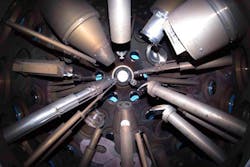Omega Laser measures fundamental nuclear-collision properties, does it better than particle accelerators
Rochester, NY--Researchers at the Massachusetts Institute of Technology (MIT; Cambridge, MA), Lawrence Livermore National Laboratory (LLNL; Livermore, CA), and the University of Rochester (U of R) have used the U of R's Omega Laser Facility at the Laboratory for Laser Energetics to do a fundamental nuclear-physics experiment—the first time such a feat has been achieved using a high-energy-density laser facility. Normally, such a thing is done using a particle accelerator.1
The scientists made precise measurements of the elastic scattering of neutrons off deuterium (D) and tritium (T) ions. They did this by using the Omega Laser to create a hot, dense plasma: the laser's 60 beams caused a 1 mm glass capsule filled with D and T to implode. A small fraction of the D and T ions fused, creating 14.1 MeV neutrons. Some of the neutrons scattered from the surrounding D and T ions, allowing a highly accurate measurement of the nuclear-collision process to be made.
Accelerator-based measurements were also used, although just to normalize the absolute cross-section. Once normalized, the shape of the low-energy cross-section was obtained with more accuracy than possible with accelerators. The results are important for nuclear astrophysics and fusion-energy research.
Next could be the fusion of 3He and 3He ions, important because it is the dominant energy-producing step by which the sun and normal-sequence stars generate their energy.
REFERENCE:
1. J. A. Frenje et al., Phys. Rev. Lett. 107, 122502 (2011).

John Wallace | Senior Technical Editor (1998-2022)
John Wallace was with Laser Focus World for nearly 25 years, retiring in late June 2022. He obtained a bachelor's degree in mechanical engineering and physics at Rutgers University and a master's in optical engineering at the University of Rochester. Before becoming an editor, John worked as an engineer at RCA, Exxon, Eastman Kodak, and GCA Corporation.
